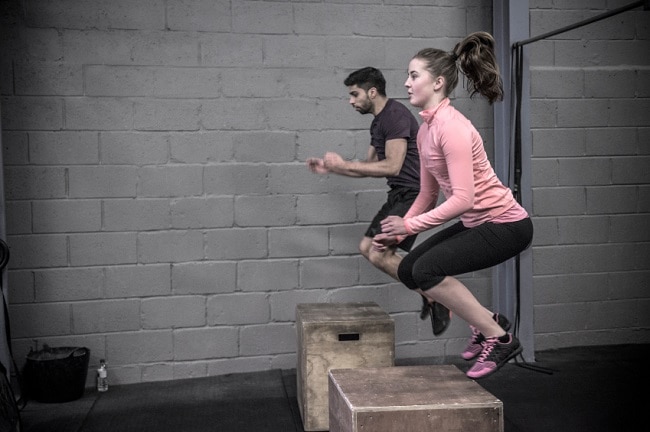“I don’t want to try the Paleo diet. I don’t like CrossFit workouts,” said a new client several years ago. She’d been working with me on her weight-loss goals. As soon as she heard the ‘P’ word, she shied away. It may come as a surprise, but the connection between CrossFit and the Paleo diet didn’t start with sparks flying. In fact, the two were distinctly separate for some time. So why did my client seem to speak to them as if they were so interchangeable?
As it turns out, she’d been exposed to something rather unfortunate: a gross misrepresentation of what the Paleo diet is. After a little prodding, I found out she’d gone to one of the many gyms that use the name “Cross Fit” without having permission to do so[1]. Not only is this harmful to the brand, but it opens the flood gate for unprofessional, unskilled and untrained people to conduct classes and offer fitness advice they aren’t necessarily qualified to give. This sort of environment increases the risk for injury.
Luckily, my client didn’t succumb to injury, but it did make her question the CrossFit lifestyle, which included the feverish popularity of the Paleo diet at the time. If only she had known more about these approaches to healthy living and how they could fit with her personal goals, maybe she would’ve left CrossFit with an open mind. In an effort to clear the air, let’s discuss this great love affair…
CrossFit from the start
So what is CrossFit? It’s a total-body fitness program founded by Greg Glassman that involves a combination of different workouts. These workouts include functional strength training, cardiovascular exercises and explosive athletic movements[2].
Paleo beginnings
And what is the Paleo diet? Rather than list everything it is not, here is what it is: With readily available modern foods, The Paleo Diet mimics the types of foods every single person on the planet ate prior to the Agricultural Revolution (a mere 333 generations ago)[3]. Today, there’s Paleo confusion everywhere. From granola bars and bread to cookies and ice cream, so many foods are being sold as “Paleo” when they are not. Paleo has taken a turn similar to other dietary approaches, which start from sound principles but eventually become trendy.
This doesn’t mean there’s zero room for indulgences on occasion – a brownie now and then is fine. Rather, the issue arises when people tend to convince themselves that because a food is marketed as “Paleo” (or gluten-free or vegan, for that matter), that it somehow gives it the equivalent nutrient density as eating a leafy green salad with wild salmon and avocado. A true Paleo diet is not that kind of trendy.
How they met
In fact, only when CrossFit found Paleo did the diet really become mainstream. CrossFit headquarters originally pushed the Zone Diet, which advocates a specific ratio of carbohydrates, protein and fat. The plan works best when food is weighed and measured. But soon, Robb Wolf, former CrossFit nutrition advisor, began covering Paleo in his CrossFit nutrition seminars, and its popularity in the community spread like wildfire.[4]
Why? Because it works. A real Paleo diet produces a lean body, which naturally leads to improved performance in fitness and in daily living.
“It’s kind of a self-fulfilling diet,” explains Loren Cordain, PhD, co-author of The Paleo Diet for Athletes. “You feel better and perform better.” Muscle growth is stimulated by branch chain amino acids, or BCAAs. Lean protein is a good source of these essential nutrients, while grains are a poor source. On a Paleo diet, you essentially eliminate grains and simply eat more meat, so you’re getting more muscle-building protein[5].
It’s not hard to understand why CrossFitters welcomed the Paleo diet with open arms – they were looking to lift heavier, do more reps, run faster and build a body they could be proud of. Does that mean you have to follow the Paleo diet if you do CrossFit or vice versa? No, not by a long shot. The balanced, seasonal and local methodology to eating, combined with CrossFit’s high-intensity workouts (led by experienced professionals) can certainly be a winning duo. But it’s not the only pairing.
What I’ve learned through working with my clients for over 20+ years is that how we look and feel is largely determined by our nutrition. As long as you’ve found a mode of regular exercise you enjoy enough to do often and focus on eating real food, you have the perfect match!
[1] “How To Find a CrossFit Gym.” CrossFit Eminence Thornton CO. N.p., 02 Sept. 2015. Web. 12 May 2016.
[2] “Paleo Diet for CrossFit.” LIVESTRONG.COM. LIVESTRONG.COM, 21 Oct. 2013. Web. 12 May 2016
[3] Cordain, Loren, PhD. “Frequently Asked Questions About The Paleo Diet | Dr. Loren Cordain.” The Paleo Diet. The Paleo Diet, n.d. Web. 12 May 2016
[4] “Behind the CrossFit-Paleo Connection.” Rodale Wellness. N.p., 13 Apr. 2012. Web. 12 May 2016
[5] “Home – The Paleo Diet™.” The Paleo Diet. N.p., n.d. Web. 12 May 2016.

